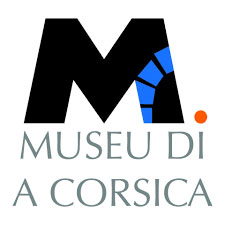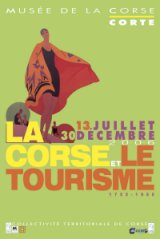“Traveling in Corsica, from the Enlightenment to the rush of the 60s
The bias of the exhibition is to plunge us first of all directly into the heart of the subject by painting a portrait of the first “travelers” in Corsica. Who were they, when did they come, why and how did they travel?
Most often it was a question of rentiers accompanied by their servants, in search of exoticism and the picturesque. In the 19th century, some Englishmen used to spend the winter in the south embarked for Corsica and adopted Ajaccio as their winter resort. Portraits, furniture, costumes, engravings, posters, guidebooks, photographs and video-montages restore this elitist and aristocratic resort.
Then the exhibition returns to history and chronology.
From Antiquity to the Enlightenment
Before the first travelers actually made the trip, the island was dreamed of, fantasized about. Indeed before the XVIIIth century Corsica is terra incognita. A set of geographical maps with the most fanciful outlines illustrate these trials and errors. The first traveler who moves in Corsica is English. In the 18th century, the island was a model of democracy for Rousseau who planned to go there and write a constitution. Boswell, fascinated by the philosopher, wanted to be his ambassador on the island. He made the trip to meet Pascal Paoli, general of the Nation. With the arrival of the cartographers and draftsmen of the Plan Terrier team, Corsica, its landscapes and its inhabitants come out of the shadows a little more.
The Grand Tour
The Grand Tour, which gave its name to tourism, was in the 18th century the journey to Italy that young aristocrats, especially British, undertook with their tutor in order to get a cultural and social education. A phenomenon that only indirectly affects Corsica, which becomes in some way, at the end of the eighteenth and early nineteenth century, an alternative to travel to Italy.
The romantic imagination
Corsica is also the homeland of Colomba, the heroine of Mérimée. When the novel appeared in 1840, it was a resounding success. The main character, close to the Italian heroines of Stendhal, becomes the emblematic figure of the vendetta. At the same time, the Corsican bandit takes his place in the European imagination. Corsica becomes a picturesque destination, deliciously risky for those who are in search of adventure! Under the Second Empire, the cult of Napoleon Bonaparte grew. Visiting the birthplace of the romantic hero became one of the motivations for travel.
Winter stays and thermalism
If the first motivation to travel was political, the following ones will be more climatic and hygienic. The 19th century is the century when winter resorts and therapeutic stays in the south of France develop. This phenomenon, in which the English spent the “winter in the South” in search of more temperate climates, was born in the last third of the 18th century in Nice and Hyères before increasing strongly in the 19th century.
The holiday resort
Ajaccio, like the Côte d’Azur, welcomed English and German winterers and saw the development of a whole district dedicated to the resort with cottages, a large hotel, an Anglican church and a whole seaside and eclectic architecture. The founders were mainly Count Baciocchi, grand chamberlain and general superintendent of the imperial theaters of Napoleon III, and a Scottish national, Thomasina Campbell. Several foreign artists in admiration of the different faces of Corsica immortalized the major sites: the forests of Bavella and Valdoniello inspired Edward Lear, Ajaccio and its surroundings were sketched by William Cowen, the ruins of Aleria by Antoine Melling, the citadel of Corte by Theodore Compton.
From seaside tourism to mass tourism
From 1925, seaside tourism predominates and then democratizes in 1936 with the first paid vacations. The exhibition ends with the evocation of the years 50-60 where we witness the advent of mass tourism.
Curator of the exhibition:
Valerie Marchi, art historian and art critic.
Scientific advisor:
Marc Boyer, historian specialized in tourism.
“Tourism, tourists, crossed glances”: works of Marcel Dinahet and Agnès Accorsi in partnership with the Lazaret and the Ollandini group.
In addition to the exhibition, the museum of Corsica has asked the artist-videographer Marcel Dinahet to create a work about tourism in Corsica. In partnership with the Ollandini company, he interfered with different groups of tourists visiting Corsica by bus or boat. He filmed people looking at the sea and wondered about the way tourists approach the landscape. What interests him in this work is the reading of the current landscape through the different means of locomotion. How one arrives on the major sites and how much the comment of the guide conditions the glance. He proposes a set of six videos presenting different views simultaneously.
Curator of the exhibition: Valérie Marchi for the museum of Corsica.




